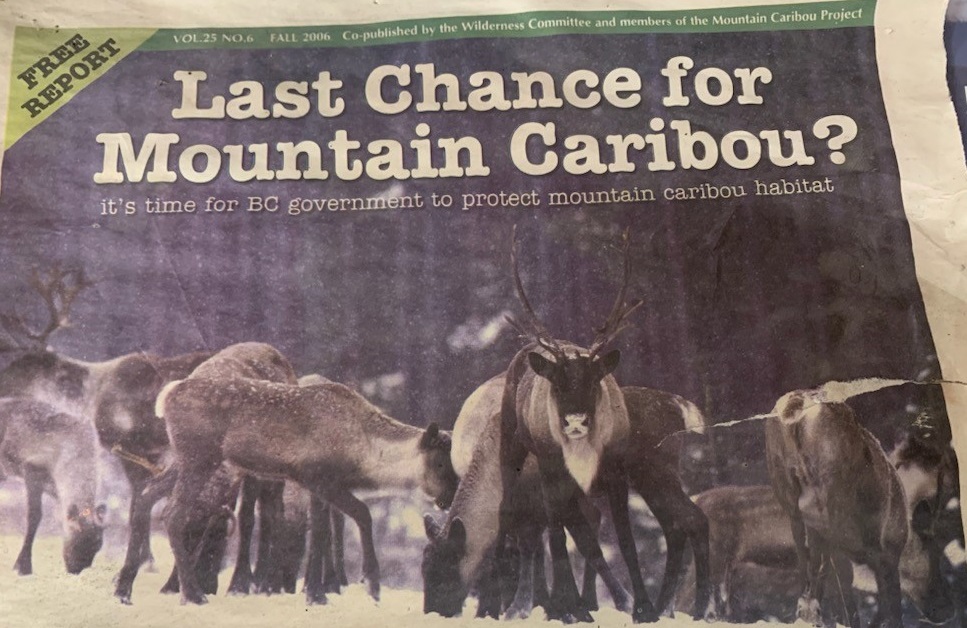Caribou have been paying a steep price for B.C.’s resource boom. They are particularly vulnerable when the landscape in their natural range is disturbed by pipelines, roads, logging and industrial development.
“We were down to 16 animals in the Klinse-Za herd and they were on their way to being extirpated,” said Carmen Richter, co-author of a 2022 study on Indigenous-led conservation published in the journal Ecological Applications. “The neighbouring herd, the Burnt Pine, is gone and the last straw was mining.”
Faced with the extirpation of another herd on their traditional territories, the West Moberley First Nations and Saulteau First Nations collaborated on a multifaceted recovery program for the local Klinse-Za herd, with the cooperation of the provincial and federal governments.
“We supplemented the herd with animals from the Scott herd to our west and went to work on some of the limiting factors like predation and nutrition,” said Richter, a UBC master’s student and member of the Saulteau First Nation.
The main pillars of the plan are predator reduction through wolf culls, maternity penning, and winter feeding. Contractors eliminated hundreds of wolves in the region, pregnant cows were captured and moved to fenced areas for their and their offspring’s protection, and the community pitched in to collect lichen as a dietary supplement.
A five-year program of wolf reduction has turned a 15 per cent a year decline in the population of the Central Group of the Southern Mountain Caribou into a 15 per cent a year increase, according to correspondence from the Ministry of Forests, Lands, Natural Resource Operations and Rural Development.
A study of 18 caribou herds released in 2019 found that populations stabilized or increased in eight of 12 herds in areas where wolves were culled. Six herds that were not subject to predator removal continued to decline, according to the study led by Robert Serrouya, director of the Alberta Biodiversity Monitoring Institute’s Caribou Monitoring Unit.
Serrouya found that predator management must be applied “intensively” to produce a positive result and that combining strategies such as culls, restoration, supplemental feeding and safe havens enhanced the effectiveness of recovery efforts. This is particularly the case for the Central Group’s Klinse-Za herd, which has shown the most dramatic recovery.
Serrouya’s study identifies predators as the most immediate cause of caribou decline, but ecosystem alteration is the “ultimate factor.”
Apart from some of the Northern Mountain herds, B.C.’s mountain caribou aren’t faring well.
The Gray Ghost caribou herd in the southern Selkirk Mountains is functionally extinct, despite a decade worth of interventions by governments to save them.
By 2019, only three females were left of a population that had 50 members as recently as 2009.
The Gray Ghosts — named for their notoriously shy habits — are the last caribou with a range in the lower 48 states of the U.S. In B.C., the George Mountain herd, the Purcell South herd and the Purcell Central herd have also perished in recent years.
A handful of caribou have been spotted in recent years near Kinbasket Lake, but it is not known if that herd is functionally reproductive.
Caribou are old-growth specialists. At certain times of the year, some herds rely on lichen that only grows on very old trees and those forests take centuries to replace. Some rely on terrestrial lichens and other forage as well.
The young forests that grow after logging also promote populations of moose and deer, the primary prey of predators, which in turn promote larger numbers of wolves and cougars. The caribou are incidental kills by these predators because the caribou have not evolved well to avoid predators in altered landscapes.

